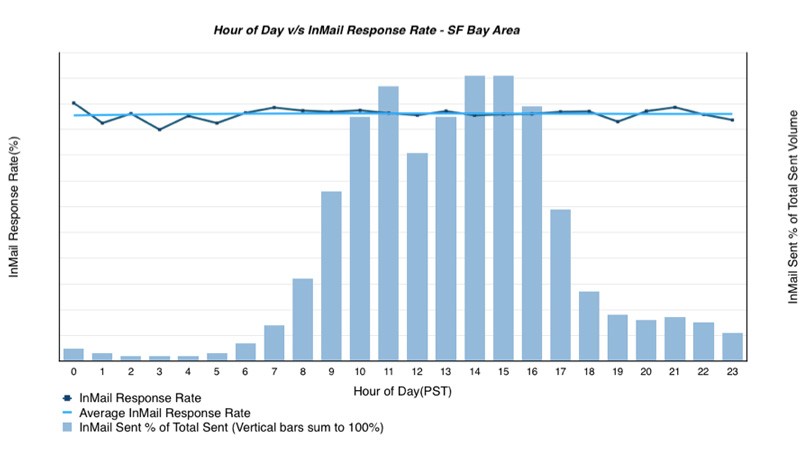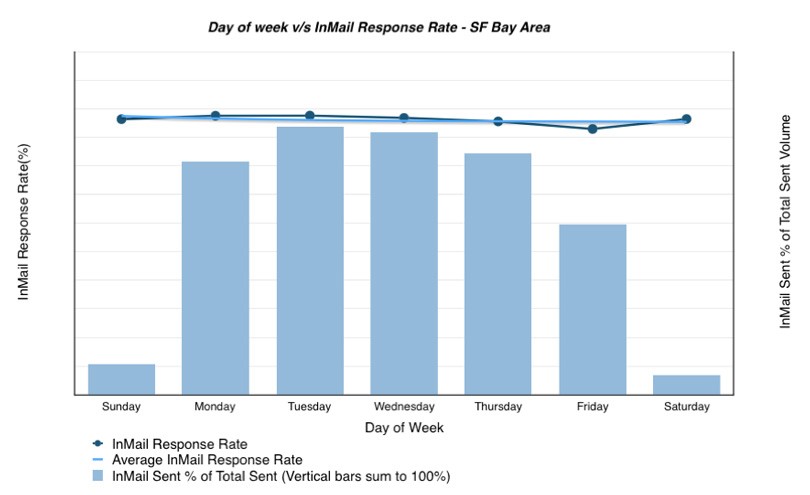Data Reveals the Best Time to Send InMails (and the Answer Will Surprise You)
Have you ever fretted over the right time to send a LinkedIn InMail to a prospect? Maybe you thought 8 a.m. on a Monday was good, or 4 p.m. on a Thursday was better. And yet, no matter what time you chose, you worried it was the wrong one?
Many recruiters stress about the perfect time because they want to get high response rates and present their company in the best light (after-hours messages, be gone!). The problem is that this has unnecessarily complicated recruiters’ daily workflows.
At LinkedIn, we crunched the numbers to find the absolute best time to send an InMail and we discovered: There is no best time. Any time of day gets fairly the same response rate because no matter when they receive the message, candidates respond only when it’s convenient for them.
However, what really drives response rates is length and personalization. The shorter and more personalized the InMail, the higher the response rate.
Let’s dive into the details.
Send InMails whenever it works best for you: there is no magical hour or day of the week
We looked at InMails data from recruiters and prospects in San Francisco, hoping to find that elusive best time to send InMails.
What we found was that far fewer InMails are sent during non-business hours; aka nights and weekends. However, the response rate to those InMails was essentially the same as InMails sent during regular business hours.
Most InMails are sent between 8 a.m. and 6 p.m. (see blue bars in the graph) but the daily response rate (represented by the blue dotted line) remains fairly close to the average overall response rate.
Same goes for the day of the week.
The graph you can see that most InMails in the San Francisco Bay Area are sent between Monday and Friday (see the blue bars). However, the response rate (again represented by the blue dotted line) to InMails is around the average. What we found here for San Francisco was also consistent globally!
InMails with short subject lines and short body perform best
We analyzed the numbers to see how length affects the response rate of an InMail. Specifically, we looked at each InMail sent in February of 2016, comparing its body word count to the response rate.
What we found is that the shorter the InMail, the higher the response rate. We did something similar for the subject line word count for InMails as well (the subject of the InMail is its title, exactly like a subject line of an email). Again, we saw that the shorter the subject line, the higher the response rate. This turned out to be true regardless of the month the message was sent.
Personalized InMails grab candidates’ attention
Finally, we wanted to see if personalization increases the chance of getting a response. And you guessed it -- the answer is a resounding yes! When we compared the response rates for recruiters who send bulk InMails to many candidates v.s. recruiters who send personalized messages to each candidate, the personalized approach was the clear winner. The same goes for InMails using templates. When recruiters send personalized messages instead of “pre-packaged” templates, candidates tend to be more responsive.
What this all means to you
The takeaway here is straightforward: It doesn’t matter when you send an InMail, so don’t spend time worrying about that. Instead, worry about the length of your message. The key is being as concise and tailored as possible, as that will increase your chance of getting a response and getting a hire faster.
To receive blog posts like this one straight in your inbox, subscribe to the blog newsletter.
Topics: LinkedIn product tips
Related articles







